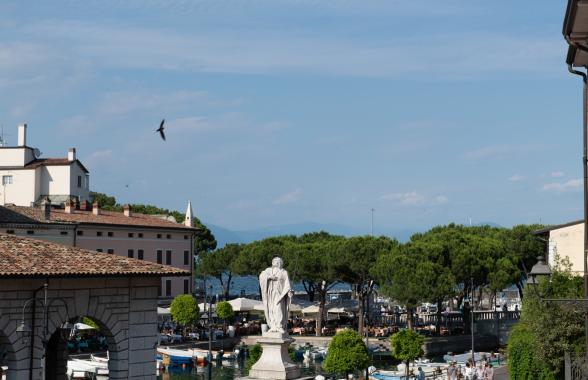Holy Angela Merici
Saint Angela Merici lived between the late fifteenth century and the first half of the sixteenth century, during an extraordinary period of intellectual, scientific and artistic ferment called the Renaissance. In religious circles during these years, the tendency developed to abandon philosophical and theological speculations to return to a concrete and personal Christian life based on meditation and on an experience of the Gospel. In this soil Angela Merici’s extraordinary spiritual experience matured, taking shape with the foundation of the Company of Saint Ursula, which would fashion a new dignity for women in a consecration lived no longer in the cloister, but in the world, within families. Her prophetic gift was not manifested in any apocalyptic or millenarian ways, but in paying attention to the signs of the times and interpreting them.
The novelty and the boldness of Saint Angela’s proposal lay in reviving the model of the primitive Church, the way of life of the apostles and the first Christian communities, in this way taking the road to a devotio moderna. Angela was born in Desenzano del Garda in 1474 into a family of the minor rural nobility that had moved from Brescia to Lake Garda to go into business. At an early age, Angela’s life was marked by losses: the deaths of her sister, to whom she was very close, and of her parents. While she was still a teenager, she went to live with a wealthy maternal uncle in Salò. She lived there for several years and became a Franciscan Tertiary connected with the Friars Minor of S. Bernardino. We do not know much of this long period of spiritual formation from her teens to adulthood. The scanty accounts that were handed down concur in emphasizing her precocious inclination to prayer, fasting and contemplation.
However, it was her sister’s death that cut most deeply into her heart, since concern for her sister’s destination in the afterlife increased Angela’s grief at losing her. The comforting vision of the “ladder” that foreshadowed the foundation of the Company of Saint Ursula is connected to this event. About its symbolism, Father Landini, of the Congregation of the Fathers of the Peace and confessor of the Company of Saint Ursula, wrote about forty years after Saint Angela’s death, “… and as she was lifted up in spirit, the sky seemed to open and a wonderful procession of angels and virgins came forth in alternating pairs, singing and playing together”. This continuous emergence of the procession of angels and virgins, linking earth to heaven, suggests Jacob’s ladder. In 1516 Angela, then about 40, moved to Brescia to Caterina Patengola’s house in order to comfort her after her children’s death. Here she started her mission of comfort and advice that would gradually expand to embrace all who came to her for prayer, mediation and peacemaking. For Angela this was a mystical period of prayer and charity. In her innermost spiritual circle, the merchant Antonio Romano; Girolamo Patengola, Caterina Patengola’s nephew; the agronomist Agostino Gallo; and Giacomo Chizzola, one of the most brilliant examples among the local patricians, ambassador of the Serenissima and founder of the Academies of Rezzato and of Brescia, all linked themselves with her. Around 1520 Angela began to undertake pilgrimages to the holy places of Christianity.
Pilgrimage has always meant a deep interior conversion that symbolizes humanity in search of Christ. Angela went back to this devotional practice that in the past had characterized the lives of other saints, such as Saint Ursula, a noble Briton and martyr of the third or fourth century, to whom Angela would dedicate the Company. For her first pilgrimage (1522), Angela chose the tomb of Blessed Osanna Andreasi, a stigmatic who had died in 1505 in Mantua. But it was the trip to the Holy Land in 1524 that assumed a particular meaning in her spiritual development. When the pilgrims’ ship arrived at Candia (Crete), an extraordinary event occurred, a sort of “inverted” miracle, the almost complete loss of her sight, preventing her from seeing the Holy Land. Her first biographers considered this event as supernatural: the Lord made her blind to require her to see through the eyes of the spirit, to refine her understanding of his plans. According to Agostino Gallo, Angela herself told him that she had seen the holy places through her inner eyes as if she had seen them with her exterior ones. After an eventful return voyage during which men and nature seemed to conspire against the pilgrims’ ship, Angela arrived in Venice late in 1524. Her reputation for holiness spread all through the city, and very many religious, gentlemen, and ladies went to meet her on her return from the pilgrimage to Jerusalem; the other travellers believed her prayers had saved them. The trip changed her very deeply, and the change must have been evident: for her, who had never been considered a “living saint”, a new dimension of public apostolate now began.
After returning to Brescia, a few months later she set off on a pilgrimage to Rome for the Jubilee Year of 1525. She was received by the Pope, who invited her to stay there among the charitable works, but she refused. When Angela returned to Brescia, she was over fifty, no longer the same “pious woman” who had set off on her first pilgrimage. The geography of her spiritual life had changed her and made her more intense, deep, wise, and especially capable of grasping the spiritual essence of things. She came back charged with a charism: her sanctity in life was well known, from the holy places of Jerusalem to Venice, centre of mercantile business; to Rome, centre of Christianity; to Milan, maybe the most important productive centre in Italy. On November 25, 1535, Saint Catherine of Alessandria’s feast, she founded the Company of S. Ursula, which immediately offered a form of asceticism of its own, connected to the eschatological value attributed to virginal consecration, but lived without canonical vows: this new state was meant for those who wanted to sanctify their lives neither by entering a monastery nor in marriage. It is the middle way, the most virtuous because in it the regeneration of life in the world develops in response to this spiritual renewal with mystic espousal. To the Company Angela left a Rule, Counsels, and a Testament of deep ascetic and spiritual value, infused with remarkable pedagogic intuition.
The new form of consecrated life, developed from the Merician inspiration, tipped the scale of women’s destinies upside down. In fact with the new Company, which came from heaven with the strength and might of the Holy Spirit, every consecrated woman could sanctify her own existence without being enclosed within convent walls, but living and working in the world on the model of the primitive Church. This implied the dignity of each “state” or condition of woman, in a world where the unmarried woman was considered with suspicion because she was neither a nun nor a wife, the only two recognized states in society; in fact their nuptial union with Christ placed these women outside the traditional schemes, putting them directly back in charge of their own honour. Obviously the Company watched over them, with its motherly-hierarchic structures, but the utter novelty of such an attitude cannot be ignored in a period when women’s freedom was being restricted.
An exceptional artist contributed to the development of Merician symbolism: Girolamo Romanino (1484-1559), with his famous painting that today is in the Brooks Memorial Gallery in Memphis. The painting is a sort of “manifesto” of the Company of Saint Ursula, with Saint Catherine of Alexandria kneeling at the centre, receiving a wedding ring from the Child Jesus, who is on Mary’s lap. On the left, in the half-light illuminated only by a distant source of light like embers, is Saint Lawrence, a reference to the vicar general of Brescia, who had approved the Rule. Slightly behind, on the right, are Saint Angela dressed as a Franciscan Tertiary and Saint Ursula, who is holding a banner and seems to show Angela the new path to set out on.
It is said that Saint Catherine’s mystic marriage has such a particular symbolic meaning for Ursulines that the Company could be defined as “the Company of Jesus’ spouses”. Coronation (with a wreath) was an important ceremony because through it the Ursuline became a “spouse of Christ”; in the painting by Romanino this dignity is represented by Saint Catherine’s crown, placed on the blades of the wheel with which she was martyred, the crown that each of Saint Angela’s daughters would take up and wear to the conclusion of her own “martyrdom”. At her death on January 27, 1540, when the news of her “passing” spread through Brescia, a big crowd gathered at St. Afra Church, which is the Sanctuary of Saint Angela Merici today; there her body lay in a open coffin. For thirty days her body remained exposed for the continuing pilgrimage of the faithful, without visible signs of decomposition. The Brescian painter Moretto (1498-1554) painted her funeral portrait.
The chronicles of the time say that after her death extraordinary events occurred and that early in the evening a bright splendour or a brilliant star appeared above the Church of St. Afra, directly over the place where the blessed body lay. After she had been venerated for over two centuries, the process for her canonization was opened in 1757 at the request of Mother Luisa Schiantarelli, superior of the Ursulines of Rome. After about ten years, in 1768, Pope Clement XIII declared Angela “Blessed”; finally Pope Pius VII canonized her in 1807. Pius IX extended her cult to the universal Church in 1861. Her feast is celebrated with great solemnity by the Ursuline Companies and institutes on January 27.













